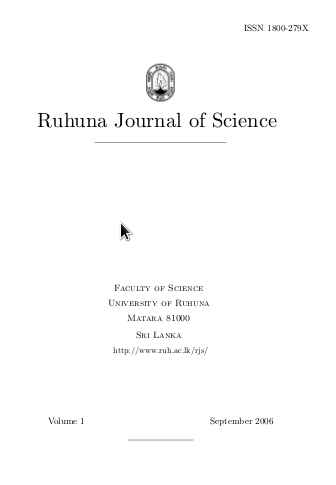Some politics and statistical physics behind Sri Lankan stock market crashes
Abstract
We investigate the mechanism of how the so called critical crashes happen in the stock market from a statistical physics point of view. We shall consider a modelling approach proposed in Johansen et al. (2000) to study the nature of a possible crash occurred in the Sri Lankan stock market in 1994 with a mentioning of the political events of the country that had been prevailing during that time which could be the key force that had driven the market towards the said crash. We shall determine the parameters that governed this crash and t a periodic function for the actual data based on the critical phenomena in statistical mechanics.We also propose a modelling approach via which we illustrate the critical crashes in the market are not unusual phenomena when the market is modeled as a system in statistical physics, where we employ a version of Deridda's Random Energy Model Derrida (1980), Derrida (1997) applied to the price uctuations in the nancial market.References
Bak P. 1996. How Nature Works: The Science of Self-Organized Criticality. Springer-Copernicus, New York.
Black, F. 1989. How we came up with the option formula. J. Portfolio management 15 4.
Buffet, E., A. Patrick, J. Pule. 1993. J. Phys. A 26 1823.
Derrida, B. 1980. Random-Energy Model: Limit of a Family of Disordered Models. Phys. Rev. Lett. 45 79.
Derrida, B. 1981. An exactly solvable model of disordered systems. Phys. Review B24 2613.
Derrida, B. 1985. J. Physique. Lett 46 L401.
Derrida, B. 1997. From random walks to spin glasses. Physica D 186{198.
Derrida, B., E. Gardner. 1985. Solution of the generalised random energy model. J. Phys C 19 2253{2274.
Derrida, B., H. Spohn. 1988. Polymers on disordered trees, spin glasses, and travelling waves. Jn. Stat. Physics 51 817{840.
Derrida B., De Seze L., Itzykson C. 1983. Fractal structure of zeros in heirachical models. Jnl. of Statisical Physics 33 559.
Dorlas, Tenuis C. 1999. Statistical Mechanics - Fundamental and Model Solutions. Institute of Physics Publishing London.
Ken Kiyono, Zhigniew R. Struzik, and Yoshiharu Yamamomoto 2006. Criticality and phase transition in stock-price
uctuations. Phys. Rev. Lett. 96 068701-1-068701-4.
Johansen A., Sornette D. 1998. Critical crashes are outliers. Eur. Phys. J. B1 141.
Paul, Wolfgang, Jorg Baschnagel. 1999. Stochastic Processes From Physics to Finance. Springer.
Schwabl, Franz. 2002. Statistical Mechanics. Springer-Verlag.
Sornette D., Bouchand JP., Johansen A. 1996. Stock market crashes, precurses and replicas. J. Phys I France 6 167{175.
Johansen A., Ledoit O., and Sornette D. 2000 Crashes as Critical Points Int. J. Theor. Applied Finance 3 219.
Williams, D. 1991. Probability with Martingales. Cambridge University Press.
Wolfram, S. 2004. http://www.wolfram.com.
Yeomans, JM. 1992. Statistical Mechanics of Phase Transistions. Oxford University Press.
Downloads
Published
Issue
Section
License
From Volume 7 (2016) onwards, all articles published in Ruhuna Journal of Science are Open Access articles published under the Creative Commons CC BY-NC 4.0 International License. This License permits use, distribution and reproduction in any medium, provided the original work is properly cited and is not used for commercial purposes.
Copyright on any research article published in RJS is retained by the respective author(s).
Authors who publish with this journal agree to the following terms:
a) Authors retain copyright and grant the journal right of first publication with the work simultaneously licensed under a Creative Commons Attribution License CC-BY-NC 4.0 International, that allows others to share the work with an acknowledgement of the work's authorship and initial publication in this journal.
b) Authors are able to enter into separate, additional contractual arrangements for the non-exclusive distribution of the journal's published version of the work (e.g., post it to an institutional repository or publish it in a book), with an acknowledgement of its initial publication in this journal.
c) Authors are permitted and encouraged to post their work online (e.g., in institutional repositories or on their website) prior to and during the submission process, as it can lead to productive exchanges, as well as earlier and greater citation of published work (See The Effect of Open Access).

